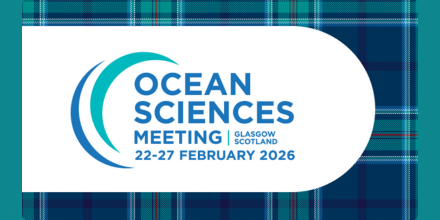US CLIVAR Related Sessions at the OSM26 Meeting

The 2026 Ocean Sciences Meeting will take place February 22-27 in Glasgow, Scotland. Contribute to "Creating a Current of Community" by submitting an abstract by August 20.
Air-Sea Interactions
- Advances in Air-Sea Interaction Observations and Remote Sensing: Autonomous Platforms, Multiscale Processes, and Cross-Disciplinary Linkages
- Observations and Modeling of Physical Processes At and Near the Air-Sea Interface
- SOLAS and SOCOM: Understanding Interactions and Feedbacks Between the Ocean and Atmosphere
- Tropical Cyclone-Ocean Interactions: From Weather to Climate
Climate and Ocean Change
- Abrupt Changes in the North Atlantic Ocean Circulation: Past, Present, and Future
- Changing Midlatitude Oceans: Dynamics, Predictability, and Links to the Atmosphere and Marine Ecosystems
- Changing Ocean Physical Conditions in a Warming Climate
- Ecological and Societal Impacts of Marine Heatwaves
- Global Teleconnection Patterns Shaping Climate Variability and Change
- Marine Heatwave Drivers and Compound Events in a Changing Climate
- Multi-scale Turbulent Mixing of the Ocean Surface Boundary Layer
- Ocean Uptake, Transport, and Storage of Heat and Carbon
- Sustained Ocean Observations for a Changing Climate: GO-SHIP
- The Southern Ocean Carbon Sink: Processes, Observations, and Change
- Variability, Circulation, and Ongoing Change in the Southern Ocean
Coastal, Biogeochemistry, and Ocean Biology
- Dynamic Coastlines amidst Changing Sea Levels: Advancements in Understanding the Impacts of Climate Change on Coastal Hazards
- Marine Carbon Cycle: Past Insights, Present Patterns, and Future Perspectives
- Prediction of the Ocean: Physics, Biogeochemistry, Ecosystems, and Applications
- Storms, Sea Level, and Shifting Seas: Reconstructing Past Coastal Hazards from Marine Archives
- Unlocking Ocean Biodiversity: eDNA, Biogeochemistry, the Discovery of New Species and Creating a Digital Ocean
Deep Sea Processes and Exploration
- Advancing Knowledge of the Atlantic Deep Sea: Exploring Biodiversity, Connectivity, and Ecosystem Function in Data-Poor Regions
- Climate Change in the Deep Sea: Impacts, Interventions, and Cumulative Stressors
- Creating Deep Impact: Strategic Alignments Across Deep Ocean Observing, Modeling, Exploration, and Technology
- Tides through Time and Space: From Deep Time to the Future Ocean
High Latitude
- Biophysical Interactions at the Poles: From the Coasts to the Open Ocean
- Coastal Sea Ice and Coupled Ocean Processes
- Exploring Beyond the Tip of the Iceberg: Understanding Coupled Iceberg Impacts on Oceans, Glaciers, and Climate
- Ice-Ocean-Seafloor Interactions and Climate Dynamics Across Timescales
- Ice Sheet-Ocean Interactions: From Micro-to Climate-Scale
- Improving Understanding of Processes in the High-Latitude and Sea-Ice Covered Oceans: Ongoing and Future Observations and Modeling Efforts
- Large-Scale Changes in the Arctic and Subarctic一Processes and Impacts
- Mesoscale and Smaller Processes in the Arctic Ocean: Dynamics, Changes, and Impacts
- Overturning Circulation and Water Mass Transportation in the Northern Oceans
- Polar Air-Sea Interactions in a Warming Climate
- Remote Sensing of Ice-Ocean Interactions in a Changing Polar Climate
- Seamounts at the Nexus of Ocean Science
- The Biogeochemical Cascade and Impacts of Climate Warming from the Cryosphere to the Ocean in High-Latitude Regions
Observations, Modeling, Data Assimilation, and Machine Learning
- Advancing in Understanding of Ocean Surface Waves at the Coasts: Evidence from New Observations and Models
- Advancing Ocean Science with Autonomous Vehicles and Sensor Technologies
- Autonomous Observing Technologies and Methods for Sustained Ocean Carbon Observations and Climate Mitigation Research
- Building an Integrated Coastal Ocean Observing System for Global Ocean, Weather, and Climate Prediction
- Co-Designing the Synergistic Ocean Observing Network for Ocean and Climate Monitoring and Predictions
- Emerging Technologies to Enhance Southern Ocean and Antarctic Observations
- Marine Environment Reanalyses and Four-Dimensional Data Driven Models: Progress and Applications
- Monitor the Future Ocean: Applications of OneArgo in Science and Operational Models
- Observational Strategies for Improving Ocean Prediction
- Revolutionising the Next Wave of Scaled and Standarised Uncrewed Ocean Observing Technologies for Global Ocean Science Data Collection
- Sustained Ocean Observing for Extremes, Tipping Points, and Climate: Emerging Opportunities with New Remote Sensing Instruments and Platforms
- Tools in Harmony: Integrating Observations and Models for Improved Understanding of a Changing Climate
